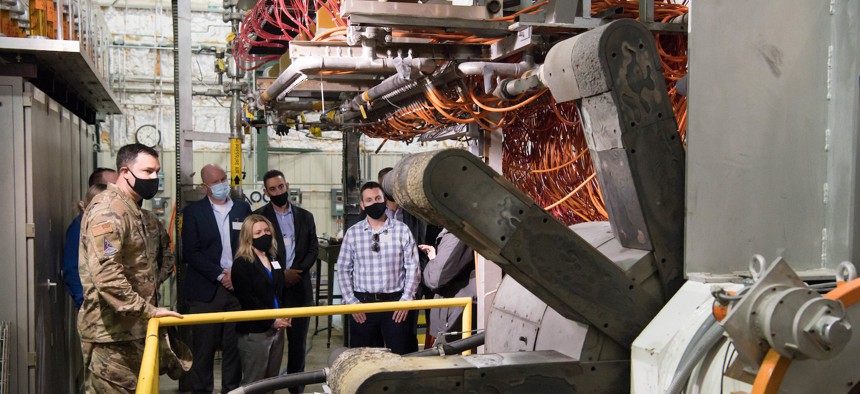
Air Force and defense industry representatives involved in the Ground Based Strategic Deterrent program tour one of the arc jet test cells at Arnold Air Force Base, Tenn., April 29, 2021. U.S. Air Force / Jill Pickett
Air Force’s Next-Gen ICBM Program Could Face Delays, Kendall Says
Though the Ground-Based Strategic Deterrent is on track at the moment, Air Force Secretary Frank Kendall isn’t sure it will stay there.
Keeping the next-generation intercontinental ballistic missile program on schedule will be “a challenge,” the U.S. Air Force said Thursday, raising new questions about the replacement for the Pentagon’s decades-old Minuteman III.
The first of the Northrop Grumman-built nuclear missiles, known as the Ground-Based Strategic Deterrent, are slated to be ready by 2029.
“As far as I know, we are still holding to the schedule for [initial operating capability]. But my sense of this is that I think it's going to be a challenge to make that,” Air Force Secretary Frank Kendall said Thursday during a House Armed Services hearing.
The Air Force is trying to address “all the possible ways that program could get in trouble,” Kendall said, since the U.S. hasn’t built ICBMs for a “very long time.”
“It's a very complicated, very large program, both of which add a lot of risk to the program,” he said. Kendall is recused from managing the Sentinel and B-21 programs because he previously consulted for Northrop, but is “monitoring” GBSD progress.
The program and its schedule are of “utmost importance” to Congress, said Rep. John Garamendi, D-Cali., and the committee will “watch it closely,” particularly since there was no competition for the contract—only Northrop bid on the program.
Northrop has achieved two program milestones for GBSD in 2023, including “its first full-scale static test fire of the stage 1 solid rocket motor and the successful completion of a series of wind tunnel tests which tested the system in both subsonic and hypersonic environments. The comprehensive test campaign validated our digital modeling and simulations and improved design maturity of the missile,” the company’s CEO, Kathy Warden, said Thursday during an earnings call.
ICBMs have become a controversial leg of the nuclear triad because the missiles are highly targetable. The amount of time the President has to decide whether to use them is small compared to bombers and submarines—both of which can get closer to the target. Additionally, the program has been criticized for its cost, which is expected to run over a quarter trillion dollars.
Designing ICBMs is also proving more difficult now that the warheads are expected to be networked and feature “some level of connectivity to the rest of the warfighting system,” said Werner J.A. Dahm, former chair of the Air Force Scientific Advisory Board.
However, in recent years, some defense officials—including former head of U.S. Strategic Command Adm. Charles Richardson—have been vocal about the importance of ICBMs in the U.S. arsenal.
It’s almost impossible for Sentinel not to be delayed or go over budget, said Hans Kristensen, director of the Nuclear Information Project at the Federation of American Scientists. Beyond GBSD, the entire nuclear enterprise is facing delays, he said.
“The problem is that planners have packed an all-of-the-above modernization for essentially the entire nuclear enterprise into more or less the same timeframe, while defense officials have been belittling warnings about cost and overloaded schedules, and scared Congress with warnings about ‘no margin left’ for the existing weapon systems,” Kristensen said.
NEXT STORY: Marines Update Evacuation Playbook




